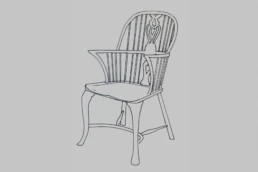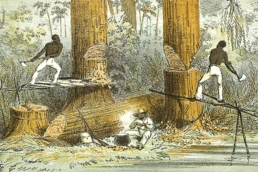“Because I know that time is always time
And place is always and only place
And what is actual is actual only for one time
And only for one place”
— T. S. Eliot, Ash Wednesday
When we attempt to trace the origins of ideas, particularly in design, there’s a temptation to simplify history into neat, localized narratives. We often conclude that design styles emerged because of a specific set of influences at a certain time in a certain place. However, reality is far more complex, as history is often nonlinear, interwoven with distant events and influences.
In design, the truth is even more fluid. Rather than viewing the emergence of design styles as a local phenomenon, we should consider how distance — both geographical and temporal — plays a critical role. Design has always been global, shaped by the movement of people, materials, and ideas across borders.
This post looks at three key moments in design history to illustrate how dislocation has shaped design, emphasizing the interplay between distance and influence. As we enter a new era where localism and sustainability are prioritized, it’s worth reflecting on how the global movement of materials and ideas has long influenced the evolution of design.
1. The Thames
Woodlands & the Windsor Chair
The Thames River serves as both a connector and a boundary between London and the countryside, and the story of the Windsor Chair illustrates how a design style can emerge through a complex interplay of places, people, and materials.
Historically, furniture design often carried a distinction between town and country styles, with town furniture typically more represented in museums and historical collections. However, the Restoration of Charles II in 1660 marked a shift in English design, spurred by a reaction against Puritan restraint and the influence of foreign craftsmen who brought Continental styles to the English court.
The exact origins of the Windsor Chair are uncertain, but its roots likely stretch back to Welsh “stick chairs,” first documented as early as the 13th century in the *Laws of Hywel Dda* manuscript. The chair that we recognize as the Windsor emerged from the beech wood forests of the Chilterns in Buckinghamshire. The spindles for the chairs were turned by local craftsmen, known as “bodgers,” who worked in the woods on rudimentary lathes, producing pieces that were eventually carried along the Thames and into London’s fashionable society.
Historian Nancy Goyne Evans offers a more nuanced view, arguing that London had already established itself as a center for turnery by the time the Windsor Chair appeared in records around 1724. According to her research, London was importing large quantities of beech from the Chilterns and may have already developed the techniques necessary for Windsor Chair production. By this theory, the chair was not purely a rural creation adopted by the elite, but rather a hybrid of influences, skills, and market demands.

Chippendale Windsor with Cabriole Legs
Later, in the 18th century, Chippendale versions of the Windsor Chair emerged, illustrating the merging of country craftsmanship with fashionable urban tastes. These chairs, produced by rural artisans imitating Chippendale’s famous designs, demonstrate the ongoing interplay between town and country, with materials and influences flowing freely between the two worlds.
2. The Atlantic
Mahogany Trading
The story of mahogany furniture in 18th-century Britain reveals a much darker side of design history, tied to environmental destruction and human exploitation. Mahogany, now synonymous with wealth and refinement, carries within its grain a history of colonialism and slavery.
Initially, mahogany was little more than a byproduct of the sugar plantations in the West Indies, felled to clear land for cash crops. The logs were used as ballast on ships returning to Britain, often dumped on the quaysides of major ports. However, as cabinetmakers began to appreciate the qualities of this dense, durable wood, mahogany quickly became the preferred material for fine furniture.
By the mid-18th century, leading furniture makers such as Thomas Chippendale were using mahogany extensively. The wood’s hard texture and fine grain made it ideal for carving intricate designs, which filled the drawing rooms of Britain’s wealthy elite. However, the true cost of this “luxury” material was paid by the enslaved laborers in the Caribbean, forced to fell trees in brutal conditions. Mahogany was a product of environmental devastation and human suffering, as entire forests were cleared and enslaved workers labored in life-threatening conditions, as observed by Charles Dickens and Wilkie Collins, who noted the “retrospective mirror-quality” of a mahogany desk, reflecting the horrors endured by those who harvested the wood.

Felling mahogany in Honduras
Thus, while mahogany furniture represented wealth and sophistication, its origins tell a much darker story, linking British homes to the human and environmental exploitation that fueled the transatlantic economy. The “age of mahogany,” as furniture historian Percy Macquoid called it, is inextricably bound to the wider forces of colonialism and slavery.
3. The Baltic Sea
Workshops, Plywood, and Wartime Europe
The story of Gerald Summers and his Simple Furniture Company in 1930s London illustrates how the flow of materials, influenced by political and economic forces, can shape — and sometimes curtail — design movements.
Summers, who began his career as an engineer, founded the Simple Furniture Company with his wife Marjorie in 1929. He quickly gained recognition for his innovative use of plywood, a material that was relatively rare in Britain at the time. Inspired by modernist movements such as the Bauhaus and the designs of Finnish architect Alvar Aalto, Summers’ furniture was characterized by its clean lines and functional simplicity.
Plywood offered unique advantages: it was lightweight, strong, and could be molded into complex shapes. Summers’ use of aircraft plywood allowed him to push the boundaries of design, as seen in his iconic Fireside Chair, which was made from a single sheet of plywood. However, his refusal to scale production or stockpile materials proved to be his undoing.
When World War II broke out, Britain’s access to Baltic plywood was severely restricted, as the material was redirected for military use. Summers’ reliance on this imported resource meant that his company could no longer fulfill orders, and by 1940, the Simple Furniture Company had declared bankruptcy.
In contrast, Alvar Aalto’s company, Artek, based in Finland and closer to the birch forests, continued to thrive. Aalto’s designs, such as the Model 60 Stacking Stool, became iconic examples of modernist furniture. The geographic proximity to resources, combined with a willingness to scale production, allowed Aalto’s work to flourish where Summers’ could not. The dislocation caused by global conflict disrupted one designer’s vision while enabling another’s success.
Design & Dislocation
These three stories — the Windsor Chair, the mahogany trade, and the rise and fall of Gerald Summers’ plywood furniture — demonstrate that design is not an isolated, local phenomenon. It is shaped by the movement of materials, the migration of people, and the impact of distant events.
The Thames carried beech wood from the Chilterns to London; mahogany crossed the Atlantic at the cost of human suffering; plywood traveled from the Baltic to Britain, only to be redirected by war. These examples remind us that design emerges from a complex web of influences and interactions, rather than a single point of origin.
As we face new challenges in design, particularly the need for sustainability and localism, it’s crucial to remember the lessons of the past. Materials, ideas, and influences have always moved across borders, and while localism has its virtues, true innovation often comes from the interplay of the local and the global. Understanding the dislocated nature of design can help us create new models that are both environmentally conscious and open to fresh ideas.